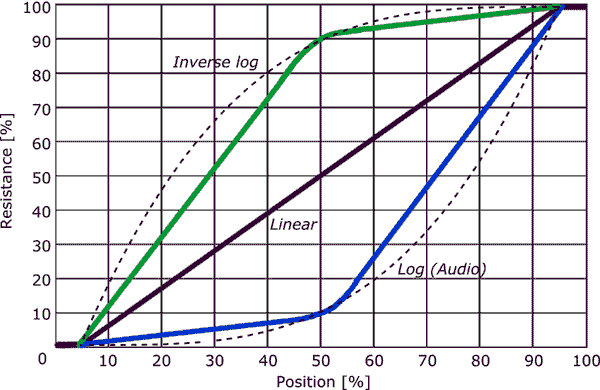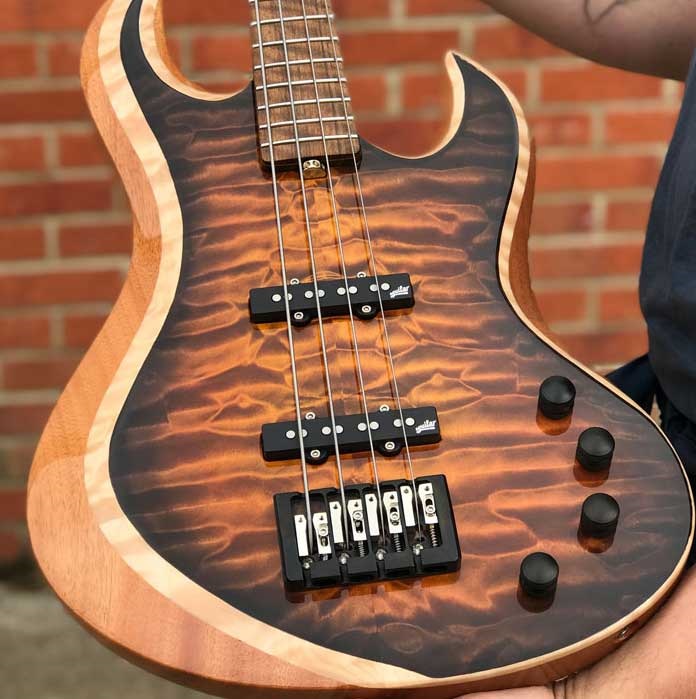This article gets a little (a lot, actually) on the techy side of things.
When it comes to potentiometers for guitars, there’s this thing called taper. There are 4 kinds of tapers, and the designations for are logarithmic (also known as audio), linear, reverse logarithmic and graphic.
Quick question answered 1: Why does the reverse log taper exist? Concerning guitar, it’s for lefty players.
Quick question answered 2: Would you ever need a graphic taper pot? No. The curve of a G taper really doesn’t suit well for musical instrument use.
Concerning guitars, the two most-often used potentiometer tapers are audio/log and linear.
What does the taper type of a pot actually do?


(An example of how potentiometer tapers look when graphed)
The taper type describes how much variable resistance happens in relation to the rotation of the potentiometer.
Linear taper pots are called as such because of how it represents itself visually on a graph. If the X axis is rotation and Y axis is resistance, the graph line drawn will be straight and usually at a 45-degree angle.
Log (as in logarithmic) taper pots represent themselves as a curved line on a graph; the reason these are also called “audio” taper pots is because we as humans can actually hear the the sound difference more clearly compared to linear when the pot is used.
Audio taper pots “sound linear” to human ears over actual linear taper pots because of the logarithmic curve. Why? Sound physics. Our brains interpret logarithmic as linear just because of how sound physics work; this is why stereo equipment, mixers, and of course guitars use audio taper pots so often.
I’m sure some who read this will have much to say about the physics of why logarithmic sounds linear to human ears. And if you want to post comments on that, feel free to do so, but we’re talking about practical application here when it comes to the bass guitar instrument, so I’ll leave the advanced scientific stuff out as there are audio engineers who could explain it a lot better.
What can potentiometer taper choice do for your sound?
Leaving resistance choice aside (most bass players use 250K pots because that particular resistance suits most electric bass guitar applications), pot taper choice will affect how the pot rotation affects the tone when used.
Volume control
When it comes to log/audio vs. linear on a volume control, linear will usually have a noticeably faster “cutoff”. You will lose a good amount of top-end treble quickly when you start turning a linear taper pot down from 10 when used as a volume control.
A linear taper pot volume control works for a bass player who prefers a fast cutoff and loss of treble so you don’t have to touch the tone control as often.
An audio taper pot volume control works for a bass player who prefers a more gradual cutoff when the knob is turned.
If you have no idea which taper would work better, the safe choice is to use audio/log taper pots.
Tone control
A linear taper pot in use as a tone control will not make much sense for most bass players because the cutoff is so quick when you start to turn the knob down from 10.
In plain English: A linear taper pot as a tone control would go from “full-on” to “nothing” very quickly to the point where you might not find it usable.
An audio/log taper pot on the other hand will give you the “widest” use of the pot rotation for tone control use.
Practically speaking, you will most likely get better control (as in a usable-to-your-ears sound) out of audio/log taper pots for tone control use.
Can you mix-and-match pot tapers?
Of course you can, but certain combinations work better than others, depending on application.
Let’s say for the moment you have a Fender Precision Bass in standard control layout with passive electronics using one master volume, one master tone. You really like the sound of the bass, but the pickup has too much treble for your liking and you find yourself fiddling around with both knobs too much to get the sound you want. You don’t want to change out the pickup because you like the sound of it. All you want is a faster/easier way to cut off the treble from 10 that doesn’t require turning the knob too much.
In that scenario, having a linear taper pot volume control and and audio/log taper pot tone control might be the combo you’re looking for. With the use of a linear taper pot as a volume control, all you have to do to edge off the “ice pick” treble is to turn the volume down a little instead of a lot like before. Now you can keep the volume up without “mudding out”. The tone control, most likely already being an audio/log taper pot, can be left as-is.
Is a linear taper pot the cure-all for “over-trebly” pickups?
It can be, but in the example above, the linear taper pot volume control is the kind of solution where you know up front turning the volume from 10 to 9 will edge off the treble just enough to get the sound you want, compared to edging the volume down to 7 or 6 with the audio/log taper pot.
If on the other hand you have a “treble from hell” pickup, that’s a different story and switching out to a linear taper pot won’t be the cure-all. If using a 500K volume pot, maybe switching to a 250K would help. Or if using 250K already, switching to a 100K may be the treble-cure you’re looking for.
Got bass guitar electronics questions? We can help because we know this stuff and answer tech questions about bass electronics all the time. Give us a call at +1 (877) 839-3531. You can also email us direct at sales@bestbassgear.com.




Hello can i ask?..what is the value of the master volume pots of the bass CORT B5?.cuz i want to change that bcuz it’s destroyed…is it B250K or B500K?..thank you!!
I want to change pot eyre on my Yamaha bb 5000 fret less 5string,witch pot meter can I use
Excellent! Best explanation I have ever read. Thanks